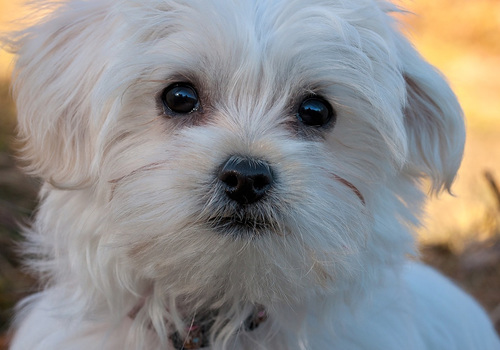The glamorous Maltese is a high-maintenance dog. The Maltese has a silky single white coat that should be groomed daily with a pin brush or a stainless steel comb to prevent or remove any mats and tangles.
Maltese who are allowed to become matted will probably need to be trimmed short because it will be too painful to comb or brush out the mats. As you comb or brush your Maltese, spray the coat with a mixture of coat conditioner diluted with water. This will help protect the hair from breakage and prevent the buildup of static. When your Maltese is dry and beautiful, pull up the hair around his face into a cute topknot or trim it so it doesn’t fall into his eyes.
Bathe your Maltese whenever his coat starts to look dingy. With the gentle pet shampoos available, you can bathe him weekly if you want without harming his coat.
Before bathing, comb the coat out thoroughly to remove all tangles. Use a whitening shampoo, followed by a conditioner for dogs with long hair. Rinse thoroughly, and then rinse again to make sure you’ve removed all the shampoo and conditioner. Use a towel to soak up as much moisture as possible, then blow dry the coat until it is completely dry. Never let your Maltese air-dry, or his coat won’t look pretty at all.
If all of this sounds like too much work, take your Maltese to a professional groomer who can give the coat the care it needs or trim it into an easy-care puppy clip that you can manage at home.
Of course, a Maltese also needs the same basic care as other dogs. Trim his nails every week or two, short enough that they don’t click on the floor, and brush his teeth frequently with a vet-approved pet toothpaste for good overall health and fresh breath.
This small dog doesn’t require a lot of exercises. Small walks, playing in your yard, and playing indoor games will give your Maltese the exercise it needs.
It’s still important to exercise your pup, as it may end up overweight. The elderly, disabled and those who live in small spaces will find that this breed will make a perfect pet.
Maltese dogs have a history of digestive issues, so it’s important to know what you are feeding it. Make sure your dog food has no fillers, such as corn, gluten or by-products. It is safe to feed them human grade food (Note: This does not mean table scraps). This dog does well with fruits, vegetables and quality proteins.
Any diet should be appropriate to the dog’s age (puppy, adult, or senior). Some dogs are prone to gettingoverweight, so watch your dog’s calorie consumption and weight level.
Treatscan be an important aid in training, but giving too many can cause obesity. Learn about whichhuman foodsare safe for dogs, and which are not.
Check with your vet if you have any concerns about your dog’s weight or diet.Clean, fresh water should be available at all times.
The Maltese is a healthy breed with few health issues, and will usually live well into the double digits.Responsible breedersscreen their stock for health conditions such as luxating patella and heart anomalies such as PDA (patent ductus arteriosus). It is recommended that Maltese puppies be bile-acid tested to rule out congenital liver issues such as liver shunt and microvascular dysplasia (MVD).
There have been reported incidences of Maltese developing encephalitis (aka as GME). At this time, there is no screening test available. The American Maltese Association is working with researchers to come up with answers and perhaps a genetic test in the near future.
As in all toy breeds, dental maintenance is important, and Maltese should have their teeth brushed daily with a toothpaste specially formulated for dogs, as well as routine cleanings at the vet.
Known to be an intelligent breed, the Maltese is easy to train but hard to housebreak. The best way to housetrain is to use a crate or keep your dog under vigilant supervision. Keep them with you in the house on a leash, and if you can’t watch them, your dogshould be in its crate at these times.
It will also help if you take them outside to do its business before and after playing and eating, when they wake in the morning, and before they go to sleep for the night. Be sure to use treats and lots of praise when your Maltese goes outside.
The Maltese needs plenty of socialization and exposure to different people, places and animals starting from a young age. The breed is naturally inquisitive, but if not socialized properly, this dog may become shy and fear aggressive.
Socialization should always be is fun, and feel free to use treats and other rewards when your dog reacts positively toward strangers. You’ll have to keep an eye (or an ear) out for barking issues – this breed can get in the habit of barking excessively, and it’s a hard habit to break.
Before settling on a Maltese, be sure that you have the time to devote to training your dog. This breed requires time and lots of love – but in our opinion, it will be well worth it.













